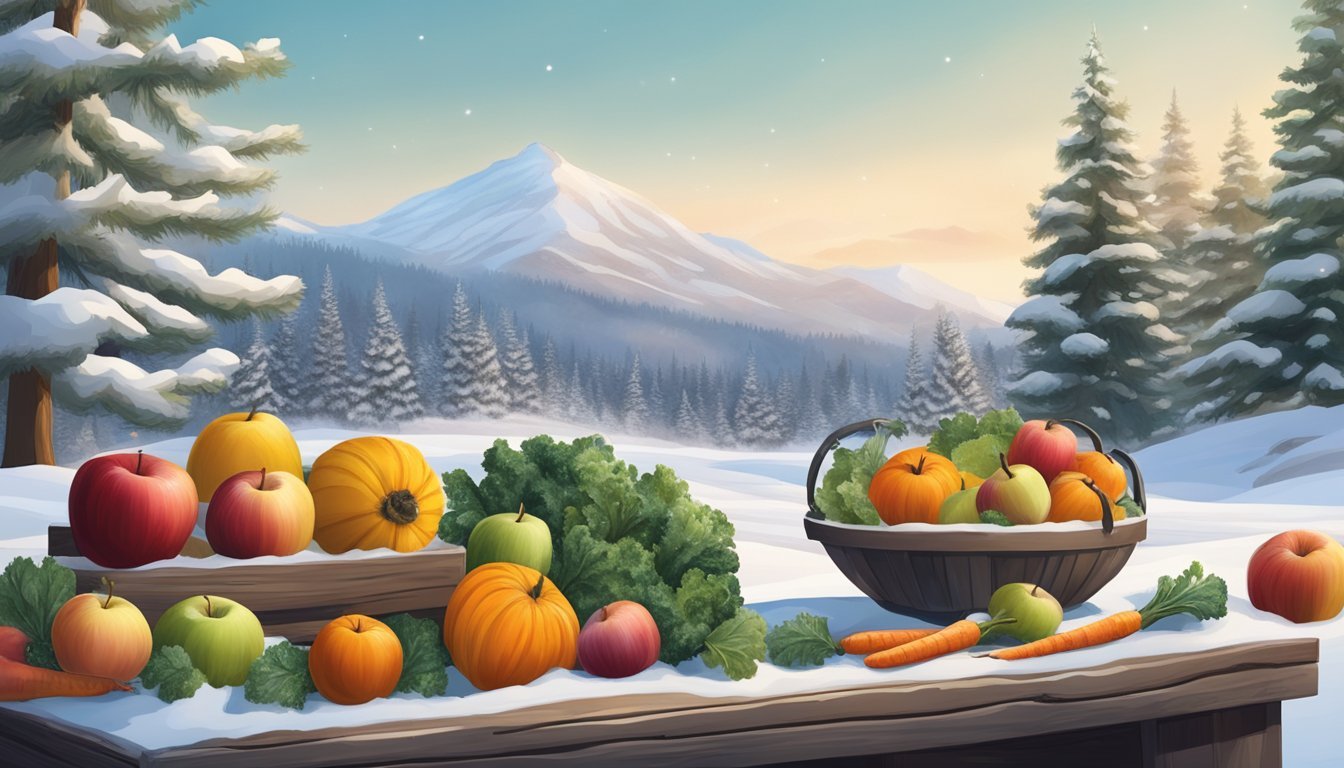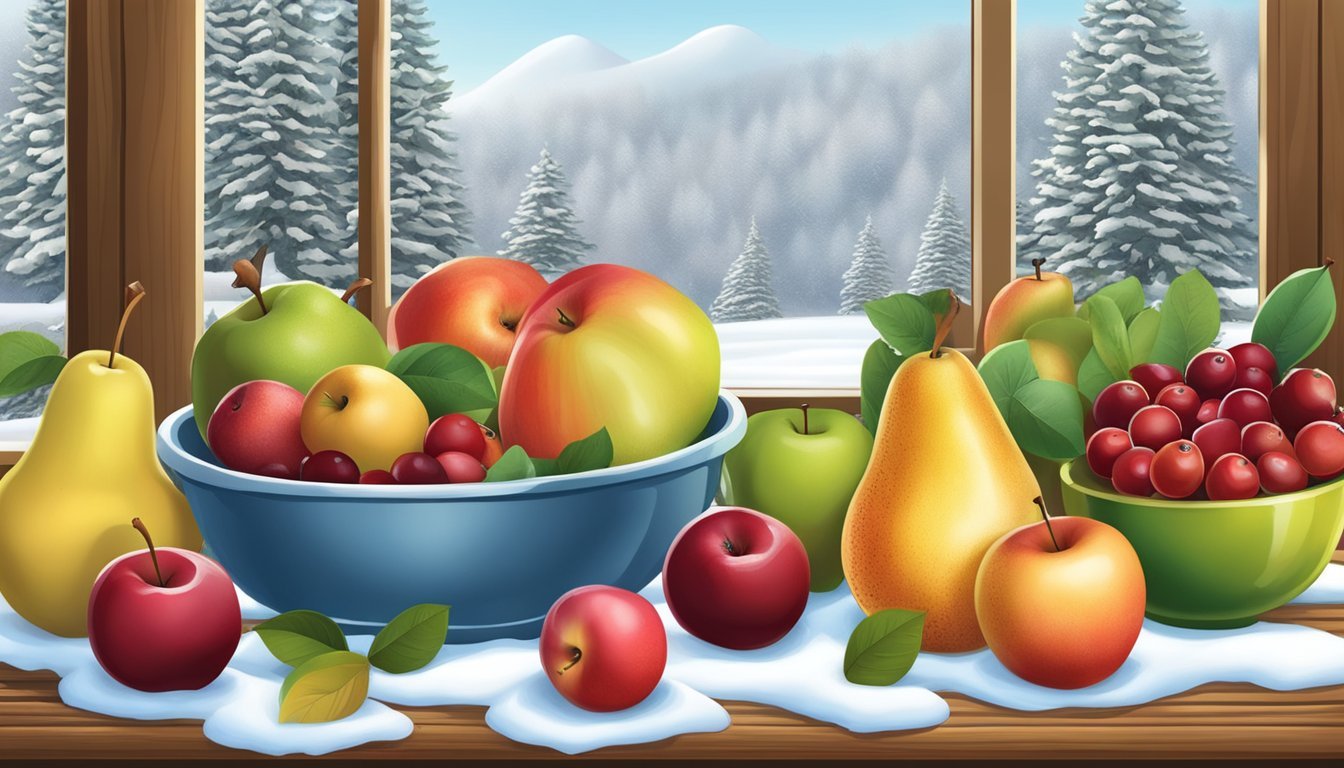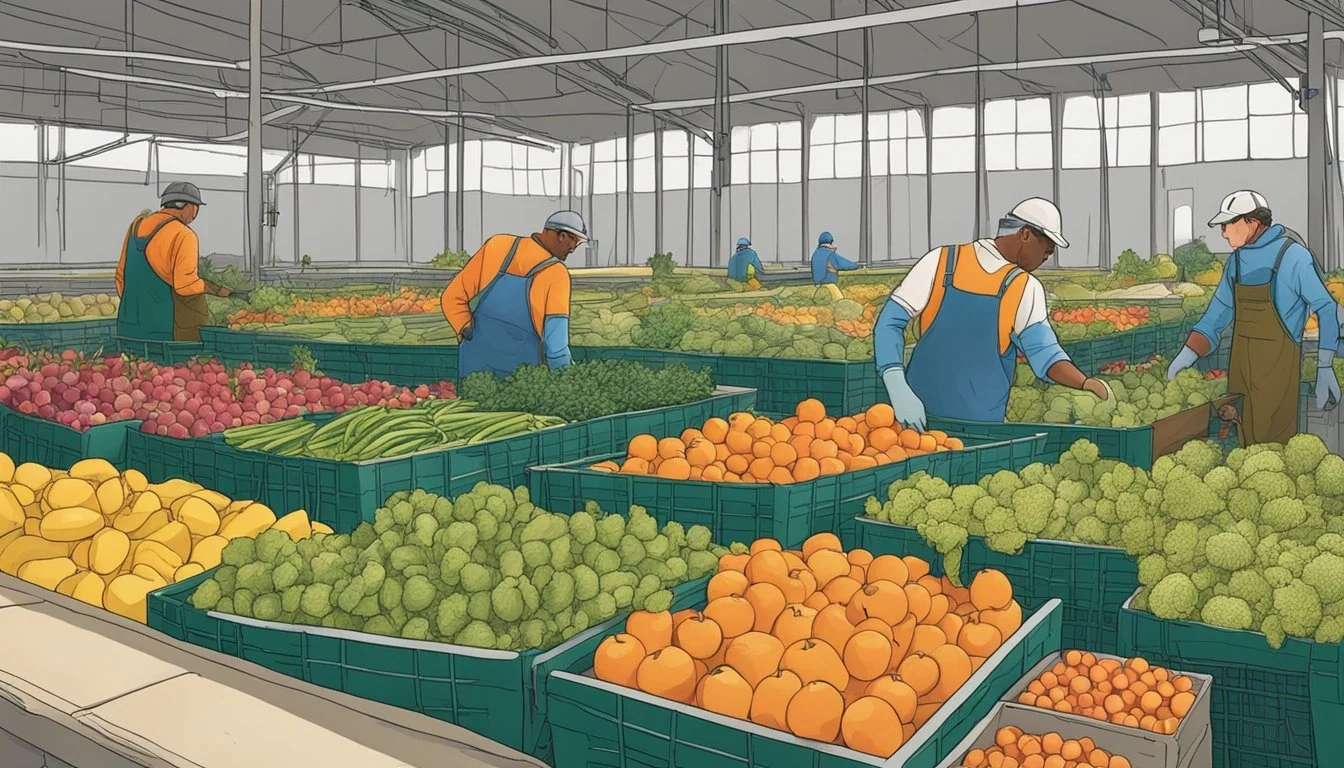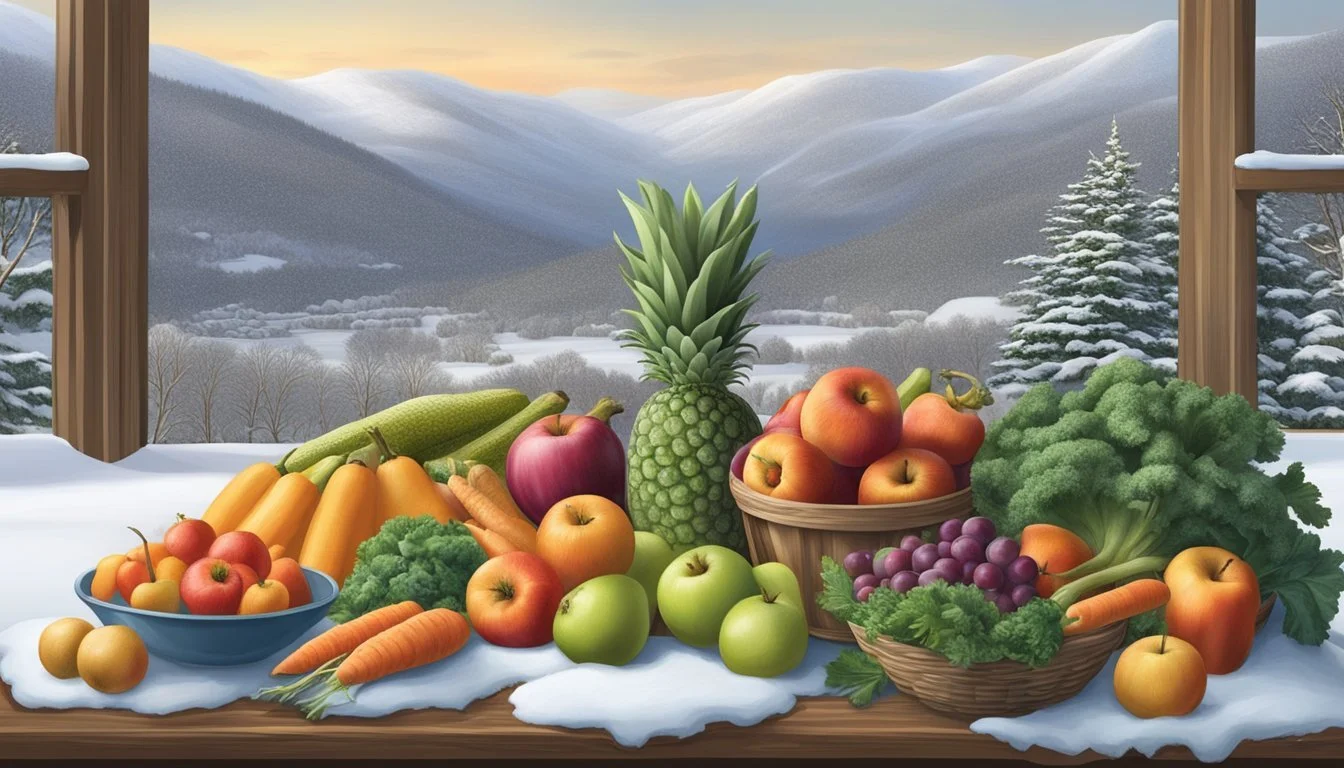New Hampshire Seasonal Fruit & Vegetables in January
A Guide to Winter Produce
This Article is Part of our New Hampshire Seasonal Fruit & Veg Calendar
New Hampshire's climate presents a unique growing environment for local produce, which shifts with the seasons. January often restricts the availability of fresh produce due to the state's cold winter conditions. Yet, even in the midst of winter, the resourceful regional agriculture continues to yield a selection of hardy fruits and vegetables. Root crops and storage vegetables are typically the stalwarts of local produce offerings during this time.
In the first month of the year, consumers can expect to find storage crops such as potatoes, onions, and carrots (how long do carrots last?), which are harvested in the fall and keep well through the colder months. Apples (how long do apples last?), another long-lasting fruit, are often available from late-season varieties that were picked in the autumn. Greenhouse-grown produce also begins to play a pivotal role in maintaining a supply of fresh vegetables, including leafy greens like spinach and kale, in January.
The emphasis on seasonal eating in New Hampshire reflects an understanding of the rhythms of local agriculture and an appreciation for the fresh flavors that peak at different times of the year. While January's selection is more limited compared to other months, it showcases the region's capacity to provide fresh, seasonal food even during the coldest part of the year.
An Overview of New Hampshire’s Winter Produce
January in New Hampshire is a time when the winter season affects both the weather and the produce available. Fresh, local fruits and vegetables are more limited due to the cold climate, but certain hearty crops still thrive and are available for consumers seeking nutritious, seasonal food.
Seasonal Highlights
Root vegetables: Carrots and beets (how long do beets last?) can withstand the cold and are often available.
Leafy greens: Kale and spinach are capable of growing in cooler temperatures.
Stored produce: Apples and potatoes, harvested in the fall, can be stored and used throughout the winter months.
Greenhouse-grown veggies: Some farmers utilize greenhouses to grow tomatoes and herbs even in winter.
Climate Influence
Temperature: The cold temperatures of New Hampshire’s winters necessitate hardy or indoor-growing crops.
Weather patterns: Snowfall and frost can limit what is able to grow or survive the winter months.
Storage techniques: Many farmers rely on crop storage to extend the availability of certain produce into the winter season.
Health Benefits
Nutrient-rich: Winter produce like kale and carrots are high in vitamins and minerals.
Seasonally fresh: Consuming produce that is available in season can ensure higher nutrient content.
Support for local immune systems: Winter vegetables can provide the necessary nutrients to support the immune system during the colder months.
Fruits Available in January
In January, New Hampshire offers a limited selection of fruits, with citrus varieties being prominent alongside stored harvests from prior months.
Citrus Varieties
Despite the chilly New England winters, consumers can still enjoy a range of citrus fruits during January. These fruits are typically imported from warmer climates as New Hampshire's winter does not support local citrus growth. The available citrus varieties generally include:
Oranges
Lemons
Grapefruits
Tangerines
These citrus fruits are renowned for their vitamin C content and their bright, refreshing flavors that can help offset the heavier foods often consumed during winter months.
Stored Harvest
Local orchards in New Hampshire typically offer stored apples and pears from the previous fall harvest. These fruits are kept in controlled environments to slow down the ripening process and preserve their freshness. Commonly available stored fruits may include:
Apples: Varieties like McIntosh, Empire, and Cortland.
Pears: Including Bartlett and Bosc.
While not freshly picked, these fruits have been carefully stored to maintain their quality and provide a nutritious option for consumers seeking locally sourced produce during the winter.
January’s Vegetable Bounty
January in New Hampshire presents a hearty selection of produce despite the cold climate. Sturdy root vegetables, nutrient-rich leafy greens, and diverse cruciferous selections are particularly well-suited to the winter months.
Root Vegetables
New Hampshire's winter soil yields a robust variety of root vegetables known for their long shelf life and versatility. Key players include:
Carrots: Sweet and crunchy, perfect for stews, roasts, and as a healthy snack.
Beets: Deeply pigmented, earthy vegetables; great when roasted or pickled.
Turnips: Starchy with a bite, turnips can be mashed or used in soups.
Parsnips: Resembling carrots but with a sweeter, nuttier flavor suitable for roasting or pureeing.
Radishes: Offering a peppery kick, radishes can be eaten raw in salads or roasted for a milder taste.
Leafy Greens
Even in the midst of January, leafy greens thrive, supplying a splash of color and a burst of vitamins:
Kale: A hardy green that stands up to frosts and becomes sweeter with a touch of cold.
Radicchio: With its bold red hues and bitter flavor, radicchio adds character to winter salads.
Cruciferous Selections
The cruciferous family, known for their health benefits and hearty textures, are well represented:
Cabbage: A versatile vegetable that can be fermented, stewed, or used in slaws.
Brussels Sprouts: These mini cabbages turn sweet upon roasting and offer a burst of fiber.
Harvesting and Storage Techniques
January is a pivotal month for storing overwintered produce in New Hampshire and utilizing season extension techniques. At this time, root vegetables and hardy greens are often the focus of harvesting efforts.
Harvest Timing
Root Vegetables: They can generally be harvested before the deep freeze of winter sets in and stored throughout January. Produce such as carrots, beets, and turnips are harvested in late fall.
Leafy Greens: Hardy greens such as kale might still be harvestable in January, depending on the weather and if they are protected by row covers or cold frames.
Storage Conditions
Root Vegetables: Ideal storage conditions for root vegetables involve cool, humid, and dark environments. A temperature range of 32–40°F (0–4°C) with 90-95% humidity is optimal.
Carrots and Beets: Store in perforated plastic bags to maintain humidity.
Potatoes: Keep in dark storage to prevent greening, at slightly cooler temperatures than other root vegetables.
Hardy Greens: Greens should be kept slightly above freezing and in high humidity to keep fresh. They can be wrapped in damp cloth or stored in plastic with some air circulation.
Apples: An overwintered crop, they are best kept in cold storage, where they can maintain their crisp texture and flavor for months when stored near 32°F (0°C) with proper humidity.
Cooking and Preparation Tips
In New Hampshire's cold January, seasonal fruits and vegetables can be transformed through cooking and preparation techniques that enhance their flavors and longevity. One can turn the robust offerings of the month into warming stews or preserve their crisp freshness for the weeks to come.
Recipe Ideas
Root Vegetables and Squash: A hearty stew is a fantastic way to utilize root vegetables such as parsnips, carrots, and potatoes. Their inherently sweet and earthy flavors deepen when simmered slowly.
Roasted Butternut Squash: For a simple side dish, cube butternut squash, toss it with olive oil and sea salt (how long does sea salt last?), then roast until caramelized. The roasting process highlights its natural sweetness.
Winter Vegetable Stew: Combine seasonal vegetables like turnips and squash in a stew with herbs and a robust stock. These ingredients amalgamate into a comforting bowl that exemplifies January's best flavors.
Preservation Methods
Vegetables: Many of January's offerings can be preserved to extend their shelf life while maintaining their crisp texture and flavor.
Pickling: Transform firm vegetables such as beets and cabbage into pickles. The acidic brine not only preserves them but also adds a tangy flavor, making them a great addition to salads and sandwiches.
Blanching and Freezing: Vegetables like broccoli and cauliflower can be blanched in hot water, then shocked in cold, and finally frozen. This method preserves their crisp texture and ensures they retain much of their nutritive value.
By employing these cooking and preparation tips, one can maximize the potential of New Hampshire's seasonal produce, creating dishes and preserves that embody the essence of January’s harvest.
Local Markets and Farm Stands
In January, New Hampshire's local markets and farm stands adapt to the cold season, providing a platform for the state's winter agriculture.
Market Schedule
New Hampshire farm stands operate year-round, with many adapting their offerings to include seasonal storage crops and greenhouse-grown produce. Winter market hours may vary, and visitors are encouraged to check individual farm stand schedules, as these local establishments play a crucial role in sustaining the state's food system even during colder months.
Supporting Local Agriculture
Shopping at local markets and farm stands is a direct way to support New Hampshire's agricultural community. These venues offer a variety of seasonal produce and locally made products, significantly contributing to the state's economy and preserving its rich farming heritage. Consumers can engage in this support by taking advantage of the Granite State Market Match program, which doubles the value of SNAP benefits spent at participating markets.
Seasonal Eating and Sustainability
When individuals in New Hampshire choose seasonal eating, they are engaging in a practice that promotes sustainability through local produce consumption, often resulting in both economic and environmental benefits.
Economic Impact
Choosing seasonal fruits and vegetables can greatly strengthen the local economy. In January, while the variety of local produce available in New Hampshire is limited due to the cold climate, purchasing what is in season supports local farmers and the regional economy. By investing in goods that do not require long-distance transportation, consumers help reduce transportation costs and contribute to the financial health of their local communities.
Examples of winter seasonal produce:
Stored apples from the previous harvest
Root vegetables like beets and carrots
Environmental Considerations
Seasonal eating also carries considerable environmental advantages. The energy required to grow and transport non-seasonal produce greatly exceeds that of seasonal produce. In the winter months, New Hampshire's local produce selection may be smaller but choosing available local goods diminishes the need for imported goods, which in turn reduces greenhouse gas emissions associated with transportation.
Sustainability factors of local produce:
Lower transportation energy: Less fuel consumed in bringing food from farm to table.
Reduced carbon footprint: Fewer miles traveled means a lower carbon impact on the environment.
Support for eco-friendly farming practices: Local farmers often employ sustainable methods due to closer community scrutiny and support.








